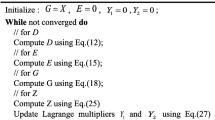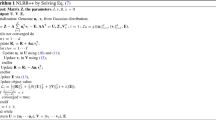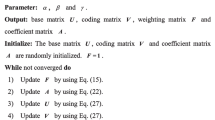Abstract
Non-negative matrix factorization (NMF), as an explanatory feature extraction technology, has powerful dimensionality reduction and semantic representation capabilities. In recent years, it has attracted great attention in the process of dimensionality reduction analysis of real high-dimensional data. However, the classic NMF algorithm is an unsupervised method in terms of learning methods. In the calculation process, the spatial structure information in the original data is often ignored, resulting in poor clustering performance of the algorithm in the subspace. In order to overcome the above problems, this paper proposes a semi-supervised NMF algorithm called semi-supervised dual graph regularized NMF with biorthogonal constraints (SDGNMF-BO). In this algorithm, the semi-supervised NMF three-factor decomposition is based on the dual graph model of the data space and feature space of the original data, which can effectively improve the learning ability of the algorithm in the subspace, and the biorthogonal constraint conditions are added in the decomposition process and achieve better local representation, significantly reduce the inconsistency between the original matrix and the basic vector. In order to prove the superiority of the algorithm under fair conditions, compares the multi-directional clustering experiments of 4 real image data sets and 1 text data set, and uses 2 clustering evaluation indexes to prove that the algorithm is better than other comparison algorithms.



















Similar content being viewed by others
Explore related subjects
Discover the latest articles, news and stories from top researchers in related subjects.References
Liu Z, Wang X, Pu J, Wang L, Zhang L (2017) Nonnegative low-rank representation based manifold embedding for semi-supervised learning. Knowl-Based Syst 136:121–129
Zheng K, Wang X (2018) Feature selection method with joint maximal information entropy between features and class. Patt Recogn 77:20–29
Xin X, Wang J, Xie R, Zhou S, Huang W, Zheng N (2019) Semisupervised person re-identification using multi-view clustering. Patt Recogn 88:285–297
Huang Q, Yin X, Chen S, Wang Y, Chen B (2020) Robust nonnegative matrix factorization with structure regularization. Neurocomputing 412
Liu X, Wang J, Cheng D, Shi D, Zhang Y (2020) Non-convex low-rank representation combined with rank-one matrix sum for subspace clustering. Soft Comput 412
Lee D, Seung H (1999) Learning the parts of objects by non-negative matrix factorization. Nature 401(6755):788—791
Lee D, Seung H (2001) Algorithms for non-negative matrix factorization. Adv Neural Inf Process Sys 13:556–562
Hoyer PQ (2004) Non-negative matrix factorization with sparseness constrains. J Mach Learn Res, 5(9):1457–1469
Hayashi T, Fujita H (2020) Cluster-based zero-shot learning for multivariate data. J Amb Intell Human Comput 12:1897–1911
Shu Z, Weng Z, Zhang Y, You C, Liu Z (2020) Graph regularized constrained non-negative matrix factorization with lp smoothness for image representation. IEEE Access 8:133777–133786
Sun F, Xu M, Hu X, Jiang X (2016) Graph regularized and sparse nonnegative matrix factorization with hard constraints for data representation. Neurocomputing 173
Jia Y, Liu H, Hou J, Sam K (2020) Semisupervised adaptive symmetric non-negative matrix factorization. IEEE Trans Cybern 1–1
Liu H, Wu Z, Li X (2012) Constrained non-negative matrix factorization for image representation. IEEE Trans Patt Anal Mach 34(7):1299–1311
Cai D, He X, Han J (2011) Graph regularized non-negative matrix factorization for data representation. IEEE Trans Patt Anal Mach Intell 33(8):1548–1560
Meng Y, Shang R, Jiao L, Zhang W, Yang S (2018) Dual-graph regularized non-negative matrix factorization with sparse and orthogonal constraints. Eng Appl Artif Intell 69:24–35
Peng S, Ser W, Chen B, Lin Z (2021) Robust semi-supervised nonnegative matrix factorization for image clustering. Patt Recogn 111:107683
Zhang L, Liu Z, Pu J, Song B (2019) Adaptive graph regularized nonnegative matrix factorization for data representation. Appl Intell 50(2):438–447
Teng X, Lan L, Zhang X (2020) Transductive nonnegative matrix tri-factorization. IEEE Access 8:81331–81347
Li H, Zhang J, Hu J, Zhang C, Liu J (2016) Graph-based discriminative concept factorization for data representation. Knowl-Based Syst 118
Zhang G, Ma Z, Huang H (2020) Dimensionality reduction of tensors based on local homeomorphism and global subspace projection distance minimum. IEEE Access 8:116064–116077
Meng Y, Shang R, Jiao L, Zhang W, Yuan Y, Yang S (2018) Feature selection based dual-graph sparse non-negative matrix factorization for local discriminative clustering. Neurocomputing 290:87–99
Li Z, Wu X, Peng H (2010) Nonnegative matrix factorization on orthogonal subspace. Patt Recogn Lett 31:905–911
Rahiche A, Cheriet M (2020) Forgery detection in hyperspectral document images using graph orthogonal nonnegative matrix factorization. IEEE Int Conf Comput Vis Patt Recogn 2823–2831
Fan S, Jia Q, Cheng W (2020) Safety monitoring by a graph-regularized semi-supervised nonnegative matrix factorization with applications to a vision-based marking process. IEEE Access 8:112278–112286
Pei X, Chen C, Guan Y (2017) joint sparse representation and embedding propagation learning: a framework for graph- based semisupervised learning. IEEE Trans Neural Netw Learn Sys 1–12
Shang R, Wang W, Rustam S, Jiao L (2016) Subspace learning-based graph regularized feature selection. Knowl-Based Syst 112:152–165
Li G, Zhang X, Zheng S, Li D (2017) Semi-supervised convex nonnegative matrix factorizations with graph regularized for image representation. Neurocomputing 237:1–11
Yi Y, Qiao S, Zhou W (2018) Adaptive multiple graph regularized semi-supervised extreme learning machine. Soft Comput 22:3545–3562
Babaee M, Tsoukalas S, Babaee M (2015) Discriminative nonnegative matrix factorization for dimensionality reduction. Neurocomputing 173:212–223
Zheng M, Bu J, Chen C A (2011) Graph regularized sparse coding for image representation. IEEE Trans Image Process 20(5):1327–1336
Shang F, Jiao L, Wang F (2012) Graph dual regularization non-negative matrix factorization for co-clustering. Patt Recogn 45(6):2237–2250
Gillis N, Glineur F (2012) Accelerated multiplicative updates and hierarchical ALS algorithms for nonnegative matrix factorization. Neural Comput 24(4):1085–1105
Shiga M, Tatsumi K, Muto S (2016) Sparse modeling of EELS and EDX spectral imaging data by nonnegative matrix factorization. Ultramicroscopy 170:43–59
Qian W, Hong B, Cai D, He X, Li X (2016) Non-negative matrix factorization with sinkhorn distance. Int Conf Artif Intell
Zhang Y, Yang Y, Li T, Fujita H (2019) A multitask multiview clustering algorithm in heterogeneous situations based on lle and le. Knowl-Based Syst 163(1):776–786
Wang H, Yang Y, Liu B, Fujita H (2019) A study of graph-based system for multi-view clustering. Knowl Based Sys 163:1009–1019
Acknowledgements
This work was funded by the National Natural Science Foundation of China,under Grant 51774219, Hubei Province Announcement System Science and Technology Project under grant 2020BED003, Key R&D Projects in Hubei Province under grant 2020BAB098.
Author information
Authors and Affiliations
Corresponding author
Ethics declarations
Conflict of Interest
The authors declare that they have no conflict of interest.
Additional information
Publisher’s note
Springer Nature remains neutral with regard to jurisdictional claims in published maps and institutional affiliations.
Rights and permissions
About this article
Cite this article
Li, S., Li, W., Hu, J. et al. Semi-supervised bi-orthogonal constraints dual-graph regularized NMF for subspace clustering. Appl Intell 52, 3227–3248 (2022). https://doi.org/10.1007/s10489-021-02522-z
Accepted:
Published:
Issue Date:
DOI: https://doi.org/10.1007/s10489-021-02522-z




